Sleepwalking in children is repeated episodes of awakening at the stage of deep sleep without obvious reasons with characteristic symptoms in the form of uncontrolled motor activity and impaired ability to think logically and coherently. The prevalence of the pathology among pediatric patients (3-10 years) is about 14-17% of the general population. In adolescence and adulthood, this figure drops to 1% of cases. The pathology occurs with equal frequency among boys and girls.
Features of childhood sleepwalking
Children most often face the problem of traveling in their sleep.
The first signs of sleepwalking may appear by the age of 3-4 years, but a large number of cases have been recorded in children 5-10 years old. At the same time, a third walked in their sleep only a few times, and 1-5% are sleepwalking children who systematically talk and move around in their sleep. This phenomenon passes by the period of puberty, on average, by 15 years. In isolated cases, a person remains a sleepwalker throughout his life. The course of somnambulism is different: some children simply go to the toilet at night, not remembering it in the morning, others pee in places not intended for this (for example, in a flowerpot, a cup), and still others perform some actions, even playing with toys. It doesn’t matter whether the child is walking with his eyes open or closed at this time - he is still in a deep sleep phase and cannot be woken up. If he is in danger, you need to try to wake up the baby in a calm voice, or gently take him by the hand and take him back to bed. Some people place a wet towel near the sleepwalker’s bed so that when he stands on it, he immediately wakes up.
The task of a parent whose child sleepwalks is to make his movements around the house as safe as possible. To avoid nighttime injuries, it is necessary to hide and set aside all dangerous objects with sharp corners. There should be no foreign objects or toys on the floor to prevent the baby from tripping over them. It is very important to close all windows and doors, because a child can easily go outside in this state or confuse a window with a door.
Parents should not regard somnambulism as a serious illness or some kind of pathology. So, sleepwalking in children Komarovsky E.O. regards it as just an age-related problem that does not require treatment. The famous children's doctor emphasizes that the main task of every parent is to do everything possible so that the child cannot fall out, climb in, or leave home. “You don’t need to fuss, but just wait, because these are temporary difficulties,” says E.O. Komarovsky.
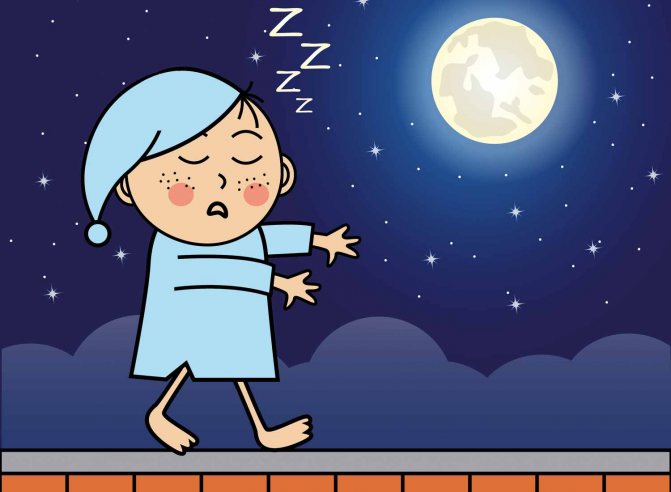
What are the dangers of sleepwalking?
Sleepwalking in adolescents is considered by experts as a normal phenomenon and does not cause concern. The exception is those cases when signs of somnambulism occur with enviable regularity and cause serious concern to both the child and his parents. The need for treatment is indicated by the presence of such factors accompanying sleepwalking:
- mechanical rubbing of hands;
- smacking;
- swallowing saliva;
- distortion;
- sudden rises from bed.
The described symptoms are characteristic of seizures, epilepsy, as well as paroxysmal sleep disorders. To avoid complications of the condition, it is imperative to show the child to a neurologist and undergo an examination.
Sleepwalking in adolescents, if it occurs frequently, can lead to injury and damage. Children while wandering in their sleep can get hurt, unknowingly harm themselves and others, stumble, fall down the stairs and even fall out of the window. The danger to life and health is due to the fact that during somnambulism, coordination is impaired and movements occur uncontrollably. Therefore, if a child experiences increased activity during sleep that can cause injury, measures should be taken to reduce the severity of signs of somnambulism.
Signs of pathology
Many parents, when they catch their child walking around the house at night, get scared, fall into a stupor, and often cause psychological trauma through their wrong actions. In order to recognize somnambulism, you need to know what symptoms it manifests.
Main features:
- The person behaves as if he were awake, but does not understand or remember what he is doing.
- The child moves around the apartment, sits on chairs, on the sofa, and also walks from room to room, opens the doors of cabinets, chests of drawers, and so on.
- Some people don’t just walk around doing nothing, but draw, play, dress, and put on shoes.
- At the same time, the person sleeps with his eyes open, his gaze as if glassy, indifferent.
- In some cases, children move around the apartment with their eyes closed. When they are unable to get around an obstacle, they can stagnate in one place for a long time.
- Pointless muttering or a whole monologue on questions asked. Either they don’t answer, or they speak unconsciously, they may even shout.
- During the daytime, there is excessive activity or, conversely, lethargy and apathy.
Little guys begin to wander in the slow-wave sleep phase, this state lasts from several minutes to an hour, on average it is 15 minutes. The onset of manifestation of the disease occurs at the age of 4-5 years; in rare cases, one-year-old children suffer from somnambulism. In the morning, the child remembers absolutely nothing, often he does not even remember what he was dreaming about.
Symptoms may vary for everyone: minor manifestations, such as night muttering, are a reason to pay attention to your child - perhaps he needs help.
Drawing conclusions
Somnambulism in childhood is not a serious problem; it occurs quite often and in most cases goes away on its own. However, parents should pay appropriate attention to sleepwalking children.
First of all, you need to make sure that the child does not have physical or psychological diseases that can cause this disorder. You should also do everything possible to prevent sleepwalking from causing injury. Drug and psychotherapy for this condition are prescribed extremely rarely.
Author: Dasha Pashchenko
Is sleepwalking recognized by modern medicine?
Scientists of past centuries considered sleepwalkers to be special people associated with the phases of the Earth's satellite. But modern science believes that:
- Somnambulism as a sleep disorder occurs as a result of overwork and stress.
- Movement during sleep begins in the phase of deep inhibition of the brain. At the same time, the subcortex of a sleepwalker does not turn off, but sends signals to perform actions.
- The attack lasts from several minutes to half an hour.
- It is necessary to protect the sleepwalker from injury by removing objects with sharp corners and made of glass from the room.
On a note!
You can't scare a sleepwalker! This can lead to serious disruptions in the functioning of his nervous system!
Teenage sleepwalking: characteristics of the condition
The main manifestations of sleepwalking are well known from films and fiction. When relatives personally experience these symptoms, it can cause
You should familiarize yourself with the symptoms, mechanisms of occurrence and factors that provoke the appearance of this condition. All this will help not only not to experience fear and panic, but also to contact specialists in a timely manner to solve the problem.
Symptoms of pathology
Manifestations of somnambulism are clearly expressed and cannot be confused with anything else:
- A teenager, without waking up, can sit on the bed, spend a little time in this state and lie down again.
- Some children get out of bed, walk around the house, can open cabinets and doors, and rearrange household items.
- In severe cases, a teenager can go outside and try to go through a window.
- Twitching of the limbs, muttering, or clear and intelligible speech are often observed.
- During an attack, the eyes can be either closed or open, while the gaze is directed into emptiness.
- During sleepwalking, children move slowly and smoothly, their movements are slightly inhibited.
- The sleepwalker does not respond to the speech of others and external stimuli.
- After waking up, children cannot remember what they did during the attack.
If a teenager experiences at least one of the symptoms described above, this indicates an attack of sleepwalking.
Provoking factors
Since the psyche of adolescents in adolescence is extremely unstable, the following factors can provoke an attack of sleepwalking:
- Insufficiently formed central nervous system. In its functioning, disruptions may periodically appear, the consequences of which are somnambulism.
- Constant and severe stress that occurs both at home and in an educational institution. Conflicts with peers, the first emotional experiences due to falling in love are also provoking factors.
- Neurotic conditions arising from stress, as well as insomnia.
- Congenital pathologies of the central nervous system and inherited mental disorders. They begin to manifest themselves at an early age and sleepwalking is one of the symptoms.
- Trauma to the skull and brain resulting from an accident, infection.
- Initial stage of epilepsy.
- Malignant and benign brain tumors.
- In rare cases, sleepwalking can occur against the background of helminthic infestation, as parasites secrete toxins that affect the nervous system.
It is important to know! A single attack can be caused by stress. If they occur regularly, this indicates the presence of a hidden disease.
Mechanism of violation formation
Sleepwalking is not a disease, and often does not pose a threat to the life and health of the child.
It occurs as a result of dysregulation of the processes of wakefulness and inhibition in the central nervous system. During sleep, the body goes into energy saving mode, many actions proceed more slowly.
In some cases, inhibition processes may not affect the areas of the brain responsible for movement and speech. It turns out that consciousness and memory are at rest, but motor activity is not, so the child can walk or perform some actions in an unconscious state.
Sometimes the inhibitory processes are not very pronounced, so the body does not completely switch to energy saving mode. This can also cause sleepwalking, and its signs will be weakly manifested.
Tactics of behavior during sleepwalking
Parents whose child walks in his sleep need to know certain rules of behavior during such a state. Many mothers and fathers communicate with “friends in misfortune” on forums, discuss their problems, and learn useful tips. Even the famous doctor Komarovsky did not ignore this pathology; he talked about somnambulism in one of his videos.
Basic rules of behavior during a “night walk”:
- the main thing is that you should not make sudden movements or utter loud sounds;
- the sleepwalker needs to be quietly taken by the hand and taken back to bed, you need to talk in a whisper, quietly;
- You can’t bother, pinch, pull your hands, or scream;
- You should not seek an answer and interrogate a person in such a state;
- You can wake up your child, but you need to do it very carefully; it’s better not to wake him up at all, so as not to scare him.
Adults must protect their baby, so follow some measures:
- You cannot leave objects in the room that could cause you to cut yourself, trip, or hit yourself.
- Put away all knives, scissors, needles, matches, lighters, etc. in the house.
- If this is a private multi-storey building, the sleepwalker's room should be on the ground floor.
- A ringing object, such as a bell, is sometimes hung in front of the door to hear the awakening of the somnambulist.
- The front door must be well locked.
- The windows also need to be tightly closed and dark curtains hung on them.
It is important to know that you cannot laugh at such a person or scold or reproach him. Ridicule can only worsen the situation: he will withdraw into himself, and even greater psychological problems will appear.
What happens if you wake up a sleepwalker?
Parents should be extremely careful when handling a sleepwalking child. It is not recommended to wake such children abruptly. The reaction of a somnambulist can be unpredictable - from crying to aggression towards others.
Parents of night travelers need to know what to do if their child sleepwalks. Those around you will need to control the movements of the sleepwalker while sleepwalking around the house and accompany him everywhere. It is necessary to protect the baby, prepare all the premises for his trips, close and drape the windows, remove traumatic and fragile objects from the path.
The children's bedroom should be furnished with furniture with rounded corners. It is better to equip the front door with reliable locks - this will prevent the sleepwalker from going outside. If sleepwalking occurs frequently, it is best to prepare for it in advance, in the evening.
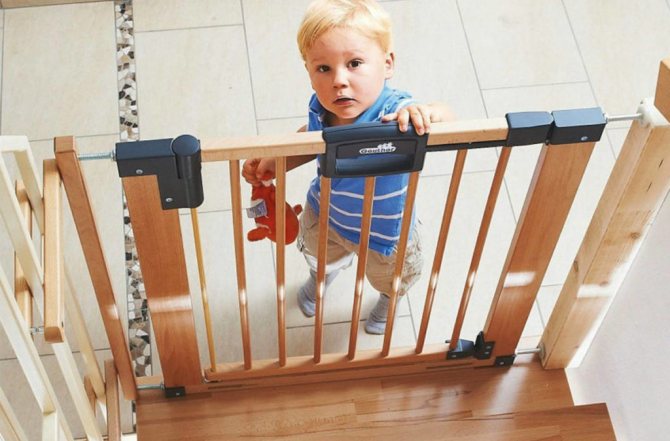
Make sure the premises are safe: close windows and doors, do not leave potentially dangerous objects in sight.
Despite the fact that during moments of sleepwalking a sleepwalking child may look intimidating, in fact he is completely defenseless. This implies ensuring control over his safety by adults.
What actions are prohibited?
It is important for family members of a somnambulist to remember that for the safety of the baby and to preserve his mental health, the following is prohibited:
- disturb the child, pull his hands;
- swear and apply pressure;
- ask him in the middle of the night about his feelings;
- place containers of cold water near the bed for a quicker awakening;
- give sleeping pills and psychotropic drugs.
Adults should not be at a loss if a child sleepwalks at night, and should decide for themselves what to do. Illiterate behavior can provoke various negative consequences - severe fear, hysterics, stuttering, enuresis, night terrors, prolonged stress.
How to avoid injury?
We have already written above that sleepwalkers can harm their health and the health of others during sleepwalking. To prevent this from happening, the following measures should be observed:
- do not leave the patient alone in the room at night (if you are nearby, you will notice the beginning of the episode in time and put the patient to bed);
- remove bunk beds, arranging a sleeping place for the patient on the first floor;
- during sleep, remove all light sources (floor lamps, bedside lamps, draw curtains so that moonlight does not pass through the window);
- block the doors and windows of the bedroom before going to bed, and if this is not possible, install bars on the windows (patients may confuse the window with the door and try to “go out” through it);
- if possible, “smooth out” sharp corners on furniture;
- before going to bed, remove objects from under the feet that the patient may stumble over, sharp and fragile objects that could injure him;
- turn off electrical appliances before going to bed, do not leave electrical wires under your feet;
- hide the keys to the front door and car;
- in severe cases, you can even tie the patient to the bed, but sometimes sleepwalkers somehow untie themselves in their sleep;
- You can also place a basin with cold water in front of the patient’s bed or lay a rag soaked in cold water - when getting up, the person will dip his feet in the water and this will wake him up.
In conclusion, I would like to repeat that in the vast majority of cases, sleepwalking is not dangerous and ends in recovery even without treatment, but sometimes it accompanies the course of quite serious diseases. Therefore, in order not to miss these most serious diseases and to prevent injury to a person during sleepwalking, you should not “wait for the weather by the sea” or treat the sleepwalker yourself: the right decision would be to seek help from a doctor.
Channel One, “Live Healthy” program with Elena Malysheva on the topic “Sleepwalking: symptoms and treatment”:
National Geographic TV channel, documentary film “Sleepwalking. Myths and reality":
Why can't sleepwalkers be called by name?
There is an opinion that nothing will happen if you wake up a sleepwalker by calling his name loudly. At this moment, a person who is, as it were, under hypnosis may not adequately assess the situation. There will be a shock from which people will come out of it in different ways. It all depends on the state of the sleepwalker’s nervous system. One may fall into hysterics, and the other may hit the person who woke him up.
Do not forget that a sharp shout will lead the somnambulist to subsequent nervous system disorders, fear of falling asleep, and insomnia.
Sleepwalking is considered a sleep disorder that occurs as a result of overwork of the nervous system. Single cases can occur in any person. Constant attacks require referral to a specialist
Description of the disease

Sleepwalking usually occurs 2 hours after going to bed.
The attack lasts no more than 15 minutes.
At this time, the patient can take a sitting position on the bed, or say some phrases.
When leaving the bed, the patient is well oriented in space and is able to answer simple questions, but cannot be awakened.
If a teenager wakes up at this moment, he does not understand his location and is not able to assess the current situation.
According to the tenth international classification of the disease, somnambulism refers to mental and behavioral disorders (code F00-F99), sleep disorders of non-organic etiology (code F51).
Most often, the pathology manifests itself at the age of 4-15 years.
Causes of sleepwalking in children
Until today, medicine does not know the exact causes of sleepwalking in children. There are only assumptions in the literature, and most of them connect somnambulism with the peculiarity of the course of certain mental processes and with the functioning of the nervous system as a whole. The determinant of sleepwalking can be stress, mental trauma, anxiety, and crisis periods of personality development. Each person reacts to events and reality in their own way, so the reasons for sleepwalking are individual for everyone.
Still, there are several explanations why a child sleepwalks:
- epilepsy;
- weak nervous system;
- chronic somatic diseases;
- experienced stress;
- dysfunctional atmosphere in the family, frequent feelings of anxiety, premonitions of something bad;
- neuroinfections;
- the child’s sensitivity to conflicts, quarrels, criticism, punishment;
- congenital pathologies;
- worm poisoning;
- heavy loads at school, as well as many extracurricular activities;
- traumatic brain injuries;
- any form of neurosis.
If we consider the causes of sleepwalking from a scientific point of view, the mechanism here is quite simple: normally, the processes of inhibition of the central nervous system do not affect the areas of the brain that are directly responsible for the coordination of movements. If this somehow happens, a person can get up in a state of sleep, go somewhere, and start talking.
There is another theory - hereditary. Some scientists suggest that the adenosine deaminase gene, which regulates the slow-wave sleep phase, is responsible for sleepwalking. How accurate this is is unknown, because other researchers believe that there are several such genes in the human genotype, but they have not yet been studied.
Provoking factors
Let's look at what causes sleepwalking most often:
- Constant lack of sleep. Continuous, sound sleep is vital for the body. Due to increased stress, frequent lack of sleep, sleep in fits and starts during the day without proper rest at night, the nervous system is exhausted from overexertion.
- Brain diseases (both benign and cancerous tumors). The tumor puts pressure on a certain area of the brain, interfering with its normal functioning. This can provoke sleep disturbances, alternating with memory loss, which is why sleepwalking occurs in adults.
- Neurological disorders. The group of these pathologies is very broad, but any of them can provoke sleepwalking. For example, an obsessive state, when one single thought firmly settles in the head and an endless cycle of thinking through its solution, causes psychosis and sleep disturbance.
- Chronic mental illnesses - epilepsy, Parkinson's disease.
- Pathologies of various organs, autonomic disorders. Aneurysms, disorders of the heart muscle, diabetes mellitus, and asthma can provoke somnambulism in adults.
- Mechanical head injuries - traumatic brain injury, brain contusions can disrupt brain function and cause sleep disorders.
- A difficult pregnancy is sometimes a circumstance that leads to sleepwalking.
- Violation of the regime and diet. Studies have confirmed that a heavy dinner right before bed has an extremely negative effect on night's rest - this causes more nightmares, which can cause a person to start walking in his sleep. Strict diets lacking beneficial microelements (magnesium) also lead to sleep disturbances.
- Excessive emotionality and extreme impressionability of some people, associated with the psychotype of the individual, can cause sleepwalking.
- Forced somnambulism. The use of alcoholic beverages, drugs, and overdose of medications cause hallucinations that lead to sleepwalking.
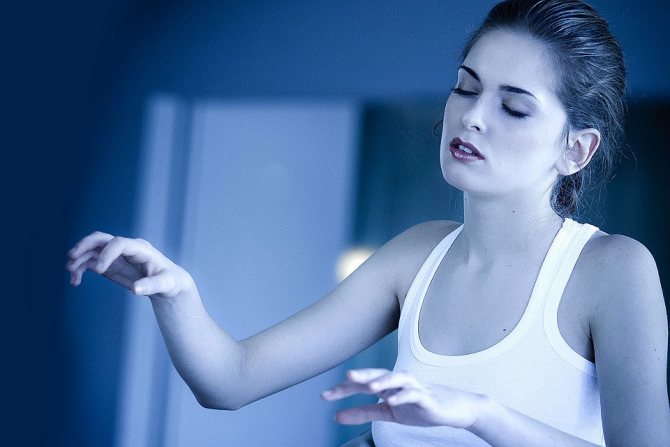
Prolonged stress can also be a cause. In the modern world, a person is constantly faced with small troubles and worries, but stress, as a chronic phenomenon, significantly affects sleep. Due to increased anxiety, a person may have nightmares or dreams in which a person is looking for a solution to a problem; this can cause him to start walking in his sleep and perform certain manipulations.
Important! During somnambulistic sleep, a person’s pain threshold is turned off, he does not experience fear, his movements are slow, his speech is sometimes sluggish, incoherent, his eyes are open, his pupils are dilated.
Prediction of cure and preventive measures
A favorable outcome depends on whether sleepwalking has a true origin or is a consequence of other problems associated with the nervous system.
Sleepwalking, caused by a fragile nervous system in children, tends to completely disappear as they approach adolescence. As a rule, such sleepwalking occurs occasionally and does not cause harm to the patient.
Somnambulism can be prevented by creating a calm and harmonious atmosphere in the home. It is advisable to limit your child's viewing of TV and computer games an hour before going to bed.
Reduce the young person's viewing of television programs containing scenes of violence, cruelty, and any that can excite the immature children's brain.

To prevent pathology, parents should monitor their child’s diet and sleep patterns.
The baby should sleep at least 8 hours, this is especially true for schoolchildren, since lack of sleep makes it more difficult for them to concentrate during the day, which causes stressful situations.
The diet should be balanced and contain vegetables and fruits. Minimize the consumption of fried and fatty foods. Before going to bed, it is useful to drink a glass of warm milk or other fermented milk product.
Before going to bed, it is recommended to take a relaxing warm bath with aromatic oils, listen to soothing music, drink a decoction of herbs or chamomile tea.
How to suspect the development of the disease?
Some mothers and fathers do not even suspect that their child is a sleepwalker. The signs are not always obvious. You can suspect the presence of an illness by the baby’s behavior. This is not difficult to do, just watch him for a while.
The following signs should alert you:
- sudden shudders and talking in sleep;
- the child sits or kneels, rocks;
- constant, identical movements during sleep, swaying of the limbs or the whole body;
- The baby first sits down, then lies forward, without waking up, and continues to sleep.
Adults should pay attention to their child’s behavior during the daytime, monitor his emotional state, and protect him from stressful situations and overexertion. Particular attention should be paid to adolescents, since hormonal changes in the body have a strong impact on the functioning of the nervous system and psyche.
The reasons for the development of night walking in some cases are severe pathologies such as epilepsy, diabetes mellitus, enuresis and others, so the problem should not be left unnoticed.
Parental behavior
In cases where sleepwalking does not pose a threat to the life and health of a teenager, treatment is not required. Sleepwalking can continue until the end of the maturation period; in only 1% of people it remains for life.
In order for the period of sleepwalking in a child’s life to pass without psychological and physical trauma, parents must make every effort to ensure a comfortable and safe environment in the family.
To do this you need to follow these rules:
- Become your child's best friend. If a teenager shares his experiences with his parents, feels their support, knows that no one will judge or scold him, the nervous system will be strong and resilient. Building trust will have a positive impact on your night's rest.
- Take the TV, computer and tablet from your child’s room. Scientists have found that children who watch movies before bed, surf social networks or play computer games are more likely to suffer from somnambulism. Explain to your child that the bedroom is a place for relaxation and there should be no household appliances in it that distract from sleep. You may immediately encounter misunderstanding on the part of your child, but be persistent and suggest listening to calm music in the evening or reading light literature as an alternative.
- Take care of your child's nervous system. Teenagers perceive all conflicts that occur in the family especially acutely, and this negatively affects the functioning of their nervous system. In order for attacks of sleepwalking to occur less frequently or disappear altogether, you need to protect the child from quarrels, fights, intrigues and other troubles. Confidence in the kindness and devotion of relatives, a calm and warm microclimate in the family will help overcome the disorder.
- Prevent the negative consequences of sleepwalking. During an attack of sleepwalking, a teenager may go outside in pajamas on a frosty night, fall down the steps, and injure himself. Parents can prevent all these consequences. Remove from the nursery all objects that could accidentally mutilate yourself, close all windows and doors tightly at night so that the sleepwalker cannot get outside. Tie a bell to the front door of your child's room, so you will wake up when the somnambulist comes out, and you can protect him from falls and injuries.
- Use relaxation techniques. Encourage your child to take a bath with essential oils of geranium, sandalwood or lavender before bed. You can also scent his room with these oils; they very well relax the nervous system and set him up for a deep, long sleep. You can put an aromatic bag of hops under the sleepwalker’s pillow. An hour before rest, it will be useful to drink a cup of soothing tea; it can be prepared from chamomile, lemon balm and other herbs.
- Make the right diet. Heavy, fatty, spicy, spicy foods, sweets, chocolate, strong tea or coffee should be excluded from the dinner menu. Your teen should eat healthy but easily digestible foods so that their digestive system can get a full night's rest. The last meal should be no later than 2-3 hours before bedtime.
- Organize a clear sleep and wake schedule. Putting a teenager to bed at 22.00-23.00 is a real problem. However, you can cheat, for example, invite your child to go jogging together in the morning, and set the alarm for 7.00. Just a few days of such early awakenings will help the teenager fall asleep earlier, and soon his body will get used to the routine.
Where to go for help?
Many people believe that there is no need to treat the disease and do not pay attention to it. In some cases, sleepwalking is actually harmless.
But sometimes it ends with disastrous consequences:
- a quarter of patients inflict injuries and mutilations on themselves; there were cases when children were circumcised, hit, or even fell out of windows;
- in rare cases, sleepwalking is accompanied by aggressive behavior. This can be associated with nightmares. People feel like they are surrounded by monsters. There are several known fatal cases of sleepwalkers killing their relatives;
- Somnambulism can serve as a harbinger of serious illnesses.
In order to avoid the development of serious consequences, it is necessary to consult a doctor for advice.
A neurologist will help adults understand this problem; sometimes somnambulists are registered with a psychologist or psychiatrist (in especially severe cases).
The baby may also suffer from other pathologies of internal organs.
When night walks are caused by stress or depression, you need to visit a psychologist: trainings and classes help to cope well with the problem. Sometimes psychological help is needed not only by the sleepwalkers themselves, but also by their household members.
Some parents don’t even notice that they themselves are “driving their offspring into a corner,” demanding too much from him, loading him with additional activities, clubs, and sections. The children's nervous system is not yet formed, not everyone can cope with difficulties, each organism is individual. Often adults start swearing and quarrels in front of all family members. It’s not for nothing that they say that if a child is nervous, the parents need to be treated first.
Help from doctors
If the cause of somnambulism is epilepsy, the teenager is prescribed anticonvulsants. For mental and psychological disorders, drug therapy can be used. A course of antidepressants, sedatives and sleeping pills can give positive results, but it is worth considering that potent psychotropic drugs have a lot of side effects and are very rarely used to treat children and adolescents.
In addition, doctors can prescribe general health-improving medications that will help make the body more resistant to stress and strain. Psychotherapy can be considered as an option; children can attend sessions on their own, and in some cases parental participation is required.
In exceptional situations, hypnosis is used, but under its influence, adolescents can behave unpredictably, so the choice of this technique must be fully justified.
Diagnosis of sleepwalking
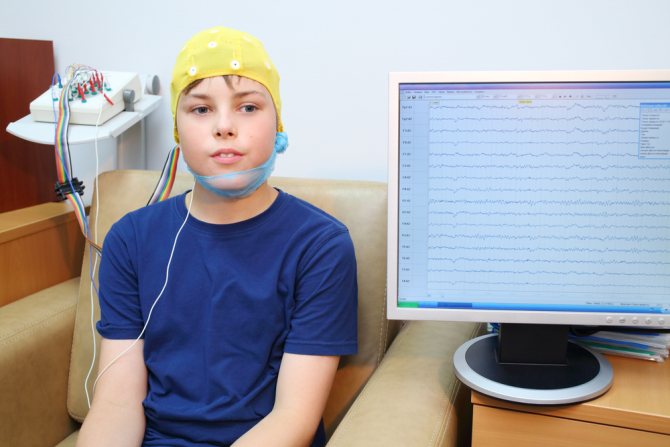
If an episode of sleepwalking occurs for the first time, and you can associate it with a stressful situation experienced the day before or overwork, then you can postpone seeking medical help. In the case when such episodes are repeated repeatedly, you should still seek help from a neurologist, neuropsychiatrist or psychiatrist to establish the cause of these phenomena.
To help a specialist make a diagnosis, you or your relatives should:
- note on paper the time of falling asleep, after what time the episode of sleepwalking begins, how long it lasts, the patient’s behavior during this period, morning awakening;
- think over and note the reasons that could provoke somnambulism (listed at the beginning of the article);
- make a list of the most commonly eaten foods and regularly taken medications.
When going to the reception, it is very advisable to take with you a witness to your nightly “travels”.
The doctor will talk with the patient, ask him a number of necessary questions, conduct an objective examination and prescribe additional research methods that confirm or refute the diagnosis. Typically, such studies are:
- electroencephalography (determining the electrical activity of the brain; it is this method that allows diagnosing the presence of epileptic foci in the brain);
- polysomnography (the patient spends the night in a special sleep laboratory, where, before falling asleep, sensors will be connected to him and changes occurring in the nervous system during sleep will be monitored);
- ultrasound examination of cerebral vessels (will determine the nature of blood flow in them);
- computed tomography or magnetic resonance imaging (will detect neoplasms, if any, or changes of any other nature);
- consultations with related specialists (endocrinologist, cardiologist, pulmonologist) for the diagnosis of somatic diseases that could provoke the development of sleepwalking.
Symptoms
Manifestations of somnambulism in children can be different: from simply sitting in bed to performing complex manipulations and walking. However, there are general symptoms by which the presence of this parasomnia is determined. First of all, there is a lack of consciousness, despite the fact that sleepwalking children move in a coordinated manner. Attempts to speak are useless, the sleeping person does not control himself, and does not realize the danger of his actions.
The eyes of a person suffering from somnambulism are open at the time of the attack, but their gaze is “absent”, directed into the distance. The face has a detached expression, indicating a lack of emotion. The end of the attack and amnesia are also characteristic.
After some time, the child returns to bed or lies down in another place, falling asleep completely. After waking up, he does not remember anything about what happened at night, and if he manages to wake him up, he does not immediately realize what is happening and may cry.
Children during sleepwalking should be distinguished from children in sound consciousness who rose from their sleeping place at night by the following signs:
- Sleeping with your eyes open. Sleepwalkers also open their eyes during sleepwalking, and their pupils dilate. Facial expressions are not expressed in any way.
- Sleep can continue in a sitting position.
- Walking in your sleep, trying to go outside. Often people move light objects, open doors, get dressed, use something, perform simple actions, throw things, go to the toilet in the wrong place.
- Talking while sleeping, saying meaningful phrases, talking about something simple.
- After the bouts of sleepwalking are over, they go to bed and may find themselves in someone else’s bed. Sometimes children leave their home and fall asleep on a rug in front of their neighbors' door.
- It is difficult to wake up children in such a state; if you do this, you can scare the baby, who will not realize what is happening to him.
- Sleepwalkers do not remember anything during sleepwalking.
Symptoms that may indicate somnambulism are manifested in: talking or pronouncing individual sounds; the child can sleep with his eyes open or sleep sitting up; walking and other active activities during sleep; and a very important sign of the disease is that the baby does not remember anything about what is happening after waking up.
There is an opinion that a sleepwalker should not be awakened during sleepwalking. This is actually a myth. But you need to wake up the child in a quiet, calm voice so as not to frighten him or aggravate his mental state.
However, if we talk about the process of sleepwalking itself, the child spends time in space very well. He knows where he is going and can answer any questions posed. This behavior usually lasts no more than 15 minutes. With exceptions, we can note situations when the guys walked in their sleep for about an hour.
Such childish behavior should not be left unattended. It is recommended to seek help from a hospital, especially if:
- the child often walks in his sleep;
- episodes of somnambulism are unsafe for the baby;
- if the disease manifests itself in adolescence;
- when actions during sleepwalking are inappropriate.
It is important to understand that sleepwalking is not always caused by harmless reasons. Often, it is provoked by severe pathologies that require long-term treatment and specialist supervision.
Pathological causes of somnambulism:
- epilepsy;
- history of trauma and concussion;
- severe stress caused by external changes;
- insomnia;
- congenital mental and neurological diseases;
- neuroinfections;
- neuroses, neurasthenia;
- advanced helminthiases.
Parents can determine whether a child has sleepwalking by observing him while he sleeps. At first glance, a sleepwalker behaves normally during sleep. He moves around, moves objects, gets dressed, avoids obstacles and opens doors.
All these actions are mainly performed with open eyes, but the child does not see anything, he is simply sleeping.
Principles of treatment of somnambulism

In most children, this disorder goes away on its own as the child grows older.
If sleepwalking occurs infrequently and no pathological changes in the body have been identified, treatment consists of lifestyle modification, namely minimizing the impact of risk factors:
- regular, long (7-8 hours) night sleep;
- before bed – a relaxing ritual (for example, you can take a warm bath with relaxing oils, listen to calm music, have a soothing massage, drink mint tea, etc.);
- Avoid watching TV and working on the computer at least 2 hours before bedtime;
- eliminate alcohol consumption;
- avoid stress at work and at home, and if it happens, then try not to bring it into the house, but, so to speak, leave it at the door;
- if a child suffers from sleepwalking, then it is necessary to ensure that he adheres to the daily routine; make sure he sleeps enough to get enough sleep; limit watching TV and playing on the computer, before going to bed do not play active games, but play calm ones (for example, board games), draw, read a book or listen to pleasant music.
If the cause of sleepwalking is any medications taken by the patient, they should be discontinued or at least the dosage reduced.
If sleepwalking occurs against the background of epilepsy, the patient will be prescribed antiepileptic drugs, and when the cause is neurosis, tranquilizers and antidepressants.
If the disease is not of a neurological nature, the disease that caused it is treated (for arrhythmia, antiarrhythmics are prescribed, for diabetes mellitus, adequate hypoglycemic therapy, and so on).
If, even during treatment of underlying diseases, episodes of sleepwalking do not stop, disrupting the patient’s daily activity, and there is a risk of injury during this time, the patient may be prescribed medications that affect sleep phases. They are prescribed in low doses, the duration of treatment is from 3 to 6 weeks.
You should not wake up a somnambulist during the period of sleepwalking - this can frighten him, provoking the development of other mental disorders. You should calmly take him by the hand or shoulders and, speaking in a quiet voice, lead him into the room and put him to bed.
Sometimes psychiatrists and psychotherapists use hypnosis as a method of treating sleepwalking.
Medication methods
The choice of medications depends on the reasons that provoke the occurrence of attacks of somnambulism.
How to get rid of sleepwalking with the help of drugs:
- for epilepsy - antiepileptics;
- nervous disorders - antidepressants and tranquilizers;
- arrhythmia – antiarrhythmics;
- diabetes mellitus - medications to lower sugar levels.
For frequent attacks, drugs that affect sleep phases are prescribed in low doses. Course duration is 3-6 weeks.
ethnoscience

Traditional methods help get rid of sleepwalking, cope with nervous tension, relax, and improve the quality of sleep.
They can be used for rare attacks of somnambulism that are not accompanied by other pathologies.
How to cure sleepwalking - folk remedies.
- St. John's wort. Pour 1 liter of cold water into 100 g of dry raw materials, simmer over low heat until boiling, strain, pour into the bath. Immerse yourself in water up to the level of your kidneys. The duration of the procedure is a quarter of an hour. Carry out sessions once a week, on other days do foot baths with a decoction of St. John's wort.
- Salt. Mix 300 g of sea salt with 3 drops of pine needle essential oil and 5 drops of patchouli essential oil. Add the mixture to hot water for a bath. The duration of the procedure is 10-15 minutes.
- Herb tea. Mix 20 each of linden blossom, chamomile, lemon balm, St. John's wort, mint. Brew the collection with 500 ml of boiling water and leave in a sealed container for 20 minutes. Drink 200 ml warm before bed.
- Sage and sweet clover. Mix 40 g of each ingredient, add 1 liter of water, bring to a boil in a water bath. Cool, pour into a glass container, and leave for 72 hours. Drink 120 ml before bedtime.
A wet towel helps to stop an attack. It should be placed near the bed. When the sleepwalker wakes up and stands on him with his feet, he will immediately wake up and go back to bed.

Remedies used against sleepwalking
Sleepwalking is a benign disorder that usually resolves on its own. The main thing is to ensure the safety of the patient and those nearby: for example, you should try to gently put the sleepwalker back into bed, but wake him up so as not to cause a stage of disorientation, you should also lock the doors and remove all dangerous objects.
It is important to strictly adhere to a sleep-wake schedule to provide the body with sufficient and quiet time to rest. Go to bed regularly and do not shorten your sleep time.
anxiolytics can help , which shorten the deep sleep phase and are useful in cases of frequent (1-2 per week) episodes, sleep apnea, emotional problems, psychotherapy and behavioral therapy.
Any therapy, however, should be started and carried out under the supervision of a doctor!
What to do if your child sleepwalks at night
If episodes of sleepwalking are rare, last a short period and no pathological changes have been identified, drug therapy is not required. It is enough to follow the following recommendations:
- relaxing treatments. In the evening, it is recommended to take a bath with herbal infusions and do a massage. It would be a good idea to place your baby next to his bed with a pillow filled with herbs that have a calming effect;
- a daily repeating ritual. Every evening you should perform the same actions to promote a peaceful sleep (reading books, a glass of warm milk);
- compliance with the daily routine. The brain will function better if the child starts waking up and going to bed at the same time every day;
- elimination of negative factors. Thick curtains will help remove the light of lanterns and the moon. The room should be ventilated shortly before bedtime, and make sure that the room is calm and quiet;
- favorable atmosphere. In the evening, your baby should not eat foods that have a stimulating effect on the nervous system. In addition, in the evening you need to muffle the sounds, play calm games to prepare for bed;
- keep a diary recording the frequency and duration of episodes of somnambulism;
- provide security. If a child is a sleepwalker, you should remove objects that can cause injury, cover the corners of the furniture with special covers, and install protective fasteners on the windows.
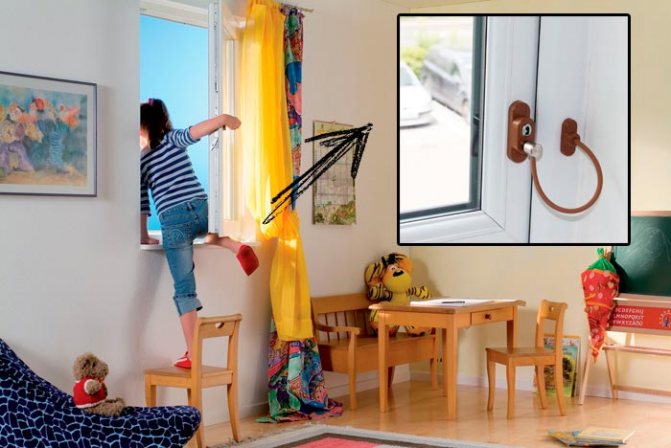
If deviations are detected during the diagnostic process, it is necessary to cure the pathology that provokes the occurrence of attacks. Therapy largely depends on the disease leading to sleepwalking:
- epilepsy. Drugs are prescribed to prevent epileptic seizures (Felbatol, Depakote);
- neurosis, depression. Sedative medications Valerian, Novo-Passit, tranquilizer medications Diazepam, Phenazepam or antidepressants Zoloft, Prozac are used. The drugs are prescribed by a doctor. Self-medication in this case is unacceptable and can aggravate the situation;
- the presence of tumors in the brain. Surgery is indicated;
- insomnia. Sedatives Novo-Passit, Persen or Valerian are prescribed. Additionally, you need to adjust your daily routine;
- parasitic infestation. In the fight against parasites, medications Pyrantel or Levamisole are used.
Children often suffer from attacks of somnambulism. There are a huge number of reasons for such changes. Often the condition is not caused by the onset of a pathological process. It turns out that it is enough to eliminate the provoking factors to avoid the occurrence of episodes of sleepwalking. Despite this, medical advice is needed. Due to this, it will be possible to exclude diseases that can also lead to sleepwalking.
Forecasts
Most often, sleepwalking is not dangerous, recovery occurs even without treatment. But often the disease is accompanied by other serious diseases that require long-term therapy.
If somnambulism is caused by mental disorders, brain tumors, epilepsy, then the prognosis for the cure of sleepwalking depends on the severity of the underlying disease.
In old age, sleepwalking develops against the background of dementia. In this case, the prognosis is unfavorable.
Sleepwalking is often observed in adults and children; the causes and treatment of the disease depend on various factors. There are many traditional and folk methods to get rid of sleepwalking. But you should start with normalizing your sleep and daily routine.
Treatment methods and advice for parents
It is extremely important for parents to know how to treat sleepwalking if their teenager experiences sleepwalking. Most often, sleepwalking does not require special treatment.
However, in some cases, episodes of sleepwalking can threaten not only the health, but also the lives of the teenager and those around him. To protect the patient, it is recommended to remove from public access all things that could cause injury or injury. Bars should be placed on the windows, and the doors should be locked from the inside with a key so that the teenager cannot open them in his sleep.

Before consulting a doctor, try to eliminate all irritating factors: TV and computer games before bed.
It is better not to carry out treatment on your own. It is also not recommended to contact traditional healers. Treatment should be prescribed by an experienced doctor. This may include:
- Hypnosis. Not all doctors recommend this method, but in some cases it can be quite effective. Even several sessions of hypnosis can normalize the rhythm of sleep and relieve a teenager from sleepwalking.
- Medicines. If sleepwalking causes drowsiness, poor coordination, difficulty learning, or other problems, your doctor may prescribe sedatives to normalize your sleep rhythm.
- General strengthening drugs. A teenager should take vitamin and mineral complexes twice a year. This will help strengthen the immune system, which normalizes sleep.
- Treatment of the underlying disease. In some cases, sleepwalking causes epilepsy and other dangerous diseases. Therefore, in order to eliminate sleepwalking, it is necessary to cure the underlying disease.
It is also recommended to show the teenager to a psychologist who will help identify hidden disorders or signs of clinical depression. To eliminate sleep disorders, a psychologist may prescribe sedatives.
Experienced psychologists advise parents of children with sleepwalking:
- control the teenager’s movements during sleepwalking;
- make the child’s room safe to minimize the risk of injury and injury during movement;
- You should not wake up your child during an attack of sleepwalking - he should be taken to the room and carefully put to bed;
- a few hours before bedtime, prohibit the teenager from watching TV, sitting at the computer, or listening to music loudly;
- Before going to bed, it is useful to brew chamomile or mint tea for your child.
Sleepwalking is one of the most mysterious and unexplored diseases. Despite many studies, it is difficult to accurately identify the cause of the disorder. To eliminate the problem, it is recommended to provide the teenager with comfortable sleeping conditions and proper wakefulness.
The phenomenon of sleepwalking, or sleepwalking, has been known since ancient times and has always caused fear in people; the exact reasons for its occurrence are still not clear. Parents who encounter this phenomenon in their own teenage children often panic and see consultations with traditional healers as the only way out of the situation. However, sleepwalking has specific physiological causes that you should be aware of in order to get rid of it.
So, why does this phenomenon occur in children during adolescence, what should parents do during an attack, and is it possible to cure this condition? All this is discussed in the article below.
Precautionary measures
Sleepwalking leads to injury. The following measures will help you avoid them:
- Tie the lunar man to the bed. But this measure is not always effective. Some patients are able to free themselves.
- Do not leave the patient alone at night. It is advisable that there are close people next to the patient who will notice the first signs of an attack and stop the patient.
- Hide the keys to the car and the front door.
- Place an alarm on the patient's bedroom door. A bell or popular wind chime can be used as an alarm. This measure will help to wake up the somnambulist himself or his relatives.
- Place a damp cloth in front of the bed. Touching a cool, wet cloth triggers awakening.
- Close all light sources: turn off the lamps, close the curtains, etc.
- Do not leave fragile objects or furniture with sharp corners on the patient’s likely path. There should be no wires on the floor.
- Lock windows and doors.
If a child sleeps on a bunk bed, he should be put to sleep only on the lower tier. Sleepwalkers should not have access to weapons.
Recommendations for parents
The child’s nervous system is a sensitive organism that reacts sharply to the slightest stress. Therefore, parents and relatives should first of all take care of a comfortable environment at home.
Don't yell at your child for the slightest offense. You need to calmly explain to your child or teenager what he was wrong about and why he shouldn’t do that.
The daily routine should include healthy sleep and moderate physical and mental stress. You need to make sure that the baby goes to bed and wakes up at the same time. Sleeping more than 8 hours can worsen the patient's condition.
It is important to give the child a rest after visiting an educational institution or kindergarten, to digest what happened during the day. The rest time should be at least one hour, after which the student can begin doing homework

At this time, you can sleep or, better yet, take a walk in the fresh air.
This will reduce fatigue and the risk of stressful situations.
The bedroom should have a comfortable temperature for sleeping and dim lighting.
The patient's diet should contain sufficient amounts of vitamins, minerals and fiber.
In the evening, it is better to exclude the following foods:
- cola;
- chocolate;
- strong black and green tea;
- coffee drinks.
It is good to include bananas in your diet. They contain melanin, which is known for its soothing and relaxing properties. You can give your child a glass of warm milk with cinnamon and a spoonful of honey at night.
You need to be extremely careful with educational institutions, because creating a friendly atmosphere there is not easy. Often, school is precisely the factor that provokes somnambulism.
If your child comes home from school irritated and upset, you need to have a conversation and ask the child to talk about his problems.
In case of aggressive behavior on the part of classmates, it is necessary to transfer the child to another school or home schooling.
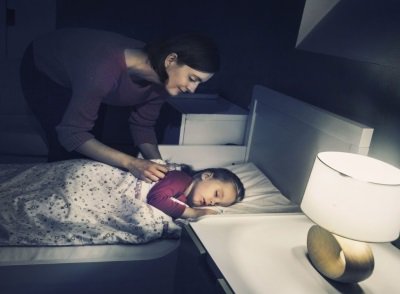
To avoid traumatic situations, parents should monitor the patient’s movement. You can install cameras and a walkie-talkie to track the child's awakening.
Under no circumstances should you wake up a somnambulist; this can lead to fear and other psychological problems. It is necessary to return the sleepwalker to bed.
To ensure maximum safety for the child during this period, the following measures must be observed:
- Do not leave the patient throughout the night and in case of attacks of sleepwalking, put him to bed.
- If the patient previously slept on a bunk bed, then it must be replaced with a regular one so that the child does not get injured if he falls.
- Lock all doors and windows. It is advisable to provide them with bars or close them so that the sleepwalker cannot open them, because the patient may confuse the window with the door and try to leave the room.
- Isolate the patient from furniture with sharp corners.
- Remove all piercing and cutting objects.
- Turn off all electrical appliances and do not leave wires on the floor.
Why do children sleepwalk?
Modern scientists continue to find out the reasons why some children sleepwalk at night. At the moment, the mechanism of the occurrence of pathology is well known. After falling asleep, inhibition processes are activated in the brain. However, they do not apply to areas responsible for motor activity. As a result, nighttime wakefulness of the body, characteristic of sleepwalkers, is observed.
Somnambulism often develops in children in the presence of the following provoking factors:
- Regular stressful situations.
- Sleep disorders.
- Chronic lack of sleep.
- Worries about punishments, conflicts with others.
- Increased emotional and mental stress.
- High degree of anxiety.
- Traumatic brain injuries.
- Neuroses.
- Past infectious diseases of the nervous system.
- Epileptic syndrome.
This disorder can also be caused by helminthiases, chronic pathologies of internal organs, encephalopathy, bronchial asthma, and gastroesophageal reflex disease (GERD). The manifestation of sleepwalking is largely facilitated by hereditary predisposition.

In order not to provoke pathology, try to protect children from stressful situations
Modern children often spend their free time at the computer. An overabundance of information and games enhance excitation processes in the cerebral cortex. This causes the development of somnambulism and difficulty falling asleep.
Interesting to know. American researchers have discovered a connection between chromosome 20 of human DNA and sleepwalking. If there is a certain part in it, the likelihood of sleepwalking doubles.










